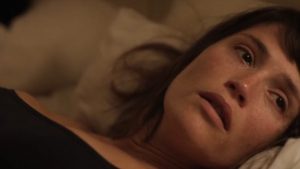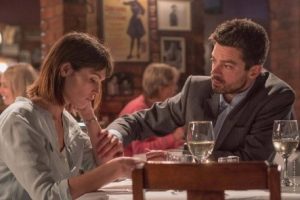The Escape, which was released in 2018 in the UK, tells the story of a woman who seems to have it all – a nice house, a handsome husband and two wonderful children. However, this life isn’t what Tara (Gemma Arterton) wants anymore and she starts to lose herself while caring for everyone else. The film illustrates how Tara is driven to the edge and escapes to Paris, away from her family. Described by Barbican as a ‘perceptive, deeply compassionate portrait of a woman on the rocky road to becoming herself’, The Escape also demonstrates the use and value of improvisation.
This film was shot, edited and made for Gemma Arterton, who worked with the director, Dominic Savage, from the beginning of production. Dominic Savage has stated that the way that he worked, namely asking questions about who the characters are and their motives rather than having a direct script, mean that “You end up with a whole load of material that’s representative of the journey you’ve been on and the choices you’ve made and it gives you complete freedom in the editing room. It’s organic, all the way through”. For us scholars, it is also interesting to study these kinds of films because we can have a gain an increased insight into the process of film-making and also can archive them for any future use.
When watching The Escape, the originality is clear. It is brutally honest and human, and this was not only because the main actors (Gemma Arterton and Dominic Copper) had worked together before in the films Tamara Drewe and A Tuttle’s Tale, but also because they were given the freedom to express how they imagined the characters to be. In this way, there were no rules that they had to abide by, but rather they could show the reality of the lives of these two characters, portraying their journeys in their own way.
The audience sees Tara in oppressive close-ups throughput the film as seen below, such as Tara peeling and scrubbing the vegetables, picking up the children’s mess, or offering drinks to friends at a barbecue Mark has offered, or many times making love seemingly just for her husband’s benefit. There are always toys strewn on the floor or cereal spilt on the kitchen table. The sex scenes are determinedly unromantic. “I am not happy. I can’t do this anymore,” is her conclusion to her current situation at home since she feels that she has lost herself and finds no comfort and happiness in her mundane, everyday life. Arterton gives a typically nuanced and sensitive performance as the wife and mother. I argue that without the freedom to express Tara’s emotions and thoughts in terms of how Gemma Arterton felt they needed to be portrayed, the film would not have as much credibility and originality. It would not have ended up with the positive response from the audience.

It is a film that touches every person that watches it and the essential stillness of Arterton’s work is a revelation. Arterton, as expressed by Hollywood Reporter Sheri Linden, has a performance that is deeply internalized and often silent, and because there is limited dialogue compared to other films. This provides the space for improvisation through physical performance, and through the way that there was lots of improvisation through the writing of Mike Leigh’s script before filming began, and also the way that the characters just simply interact with each other. Arterton’s face, regarded in somewhat overused close-up, is the movie’s central landscape, and signals with every gesture and glance that Tara’s discontent is no simple matter. Without the need to be initially bound by a script, Arterton and Cooper were free to express their characters as they saw fit and how they felt they needed to be shown. For me, it wouldn’t have worked any other way while they were questioning whether it is ever right for a mother to leave her children.

